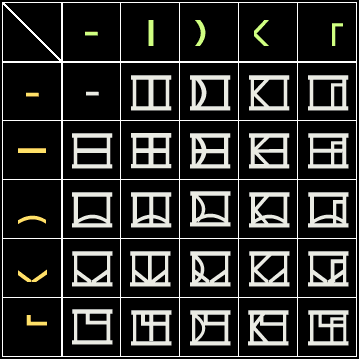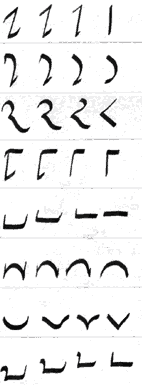![]()
![]()
As I have shown in the "system behind the letters" section, the D'ni alphabet's 35 letters (only 24 of which are considered) are built from each one of five top parts and one of five bottom parts (including the possibilities of "no bottom" and "no top"). The original order of the alphabet makes more sense now; the letters seem to be arranged by their "bottom parts". However, this discovery cannot explain why they are in exactly this order. Another theory can.
Every Riven player has to learn to decode D'ni numbers. He/she will sooner or later find out that there is a strict rule: there are four symbols for 1, 2 , 3 and 4. For the number 5, the symbol for 1 is rotated 90 degrees. The symbol for 6 is like a 5 and a 1 drawn in one single box. This continues for 7, 8, and 9. The number 10 (=2*5) is indicated by the rotated 2 symbol. All numbers up to 24 follow this system (then there has to be another D'ni digit to count further). So, you can say that every D'ni digit is made up from a "normal" part and a "rotated" part (including the possibilities of "no normal" and "no rotated"). You have to admit that there are certain parallels between numbers and letters ...
It seems as if we should take a closer look at the "basic elements" of both systems. This is what Christopher Gilson did. His result was the following:
"I think that with a little imagination you can see that in fact the 24 letters must have originated as cursive forms of the 24 digits, i.e. the D'ni numbers written smoothly with a pen, and without the boxes around them."
When he told me about this idea, I looked at the letters and at the numbers myself. I had to agree, and I think everyone will. I may illustrate the theory a bit to show the importance of this revelation:
 ...
...
In this table, the first row shows the basic elements of the letters, the
second row are the number basics.
Take a look at the two tables (one of them is from the "System of
the letters" section, that's why some letters are blue):


This shows of course that if you take any letter,
you can hardly assign it to the corresponding number. Anyway, if you take
the letter as a combination of two basic parts, and the digits as well,
you can see the relationship.
It can be taken for sure that this is not coincidence. If we assume the D'ni civilization as real (we know it's been created by Cyan, but they did it well enough to accept this assumption for a while...) and see ourselves as historians, the next question will be: have the letters developed from the numbers? Or was it the other way round? This is indeed a very interesting question. Everyone has to decide on his/her own which theory is better, but I have compiled and summarized pro & contras of each:
| (abstraction of the symbols)  |
(cursivation of the symbols)  |
| If the D'ni numbers are modified versions of the letters, this would be the same process as in some Earth languages. Ancient Greek letters, for example, were used as digits as well (with Alpha=1, Beta=2, Gamma=3 etc.) To distinguish a "letter-letter" from a "digit-letter", the digits were marked with a little apostrophe, so that A=Alpha and 'A=1. In D'ni, the boxes around the digits have the same function. (This process is also found in the Hebrew and the Georgian script.) Though, this theory cannot explain what happened with the "dotted" letters, which have no corresponding numbers. | Generally, in script history the process of cursivation, i.e. the creation of "flowing" forms from graphical symbols, can be found very often (e.g. at the Egyptian hieroglyphics (Demotic and Hieratic script). When I draw the above shown images by hand, I found that this direction is in a way more likely. Imagine an old D'ni script, every letters in boxes. That's not very practicable. Writing faster will change the symbols automatically, looking at a long time period. Furthermore, at least in our world most cultures had numbers before they began writing their language. |
Because of the fact that the single letters are not very similar to the single numbers, and thus probably not directly related, another theory is possible: Both letters and numbers have their roots in common, as you can still see at the "basic parts" which match perfectly; but the alphabet system has developed in a different direction, being optimized for fluent writing, than the digits. This would fit the facts best.
 In my sketches illustrating the possible
"development" of the symbols, look at the second last row (the
symbol for "h" or "15"). And see how the number "15"
has been written in this little box on the Book of Ti'ana map (the right
symbol).
In my sketches illustrating the possible
"development" of the symbols, look at the second last row (the
symbol for "h" or "15"). And see how the number "15"
has been written in this little box on the Book of Ti'ana map (the right
symbol).
(The D'ni text says "pb tehb" and is still unsolved.)
I may add that Christopher Gilson includes the apostrophe like in "D'nee" as the 25th letter to reach this "magic number". The corresponding number would be zero, an empty box with a little dot in the center. His linguist page can be found here.
When you look at the D'ni alphabet now and assign the numbers to every letter: the result are the numbers from 1 to 24... in their correct order...
![]()
![]()
Note: Some images on this site were produced using the Freeware Truetype "D'ni Font" by Andy Moriarity (http://web.triton.net/andym/dfont.htm). This font is very good ad contains also the numerals. It has been checked by Richard A. Watson from Cyan, so it is at least semi-official. The map in Book of Ti'ana is copyrighted by Cyan, Inc. and used with permission.